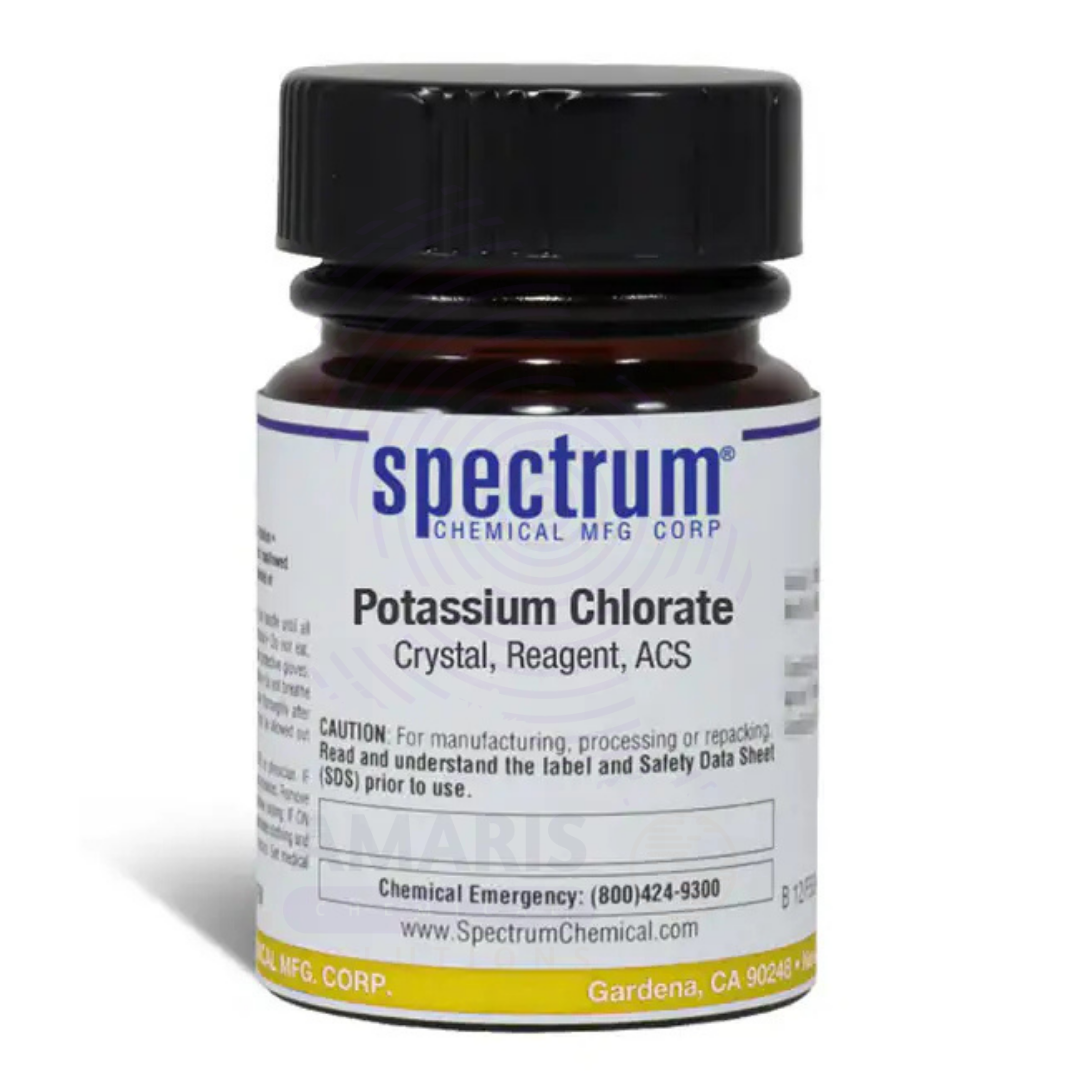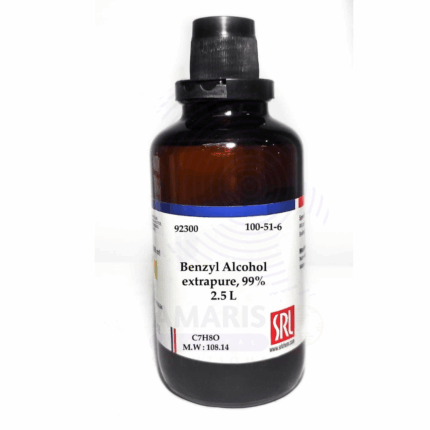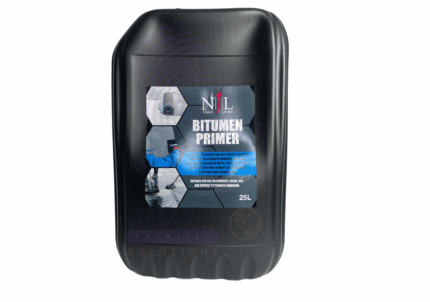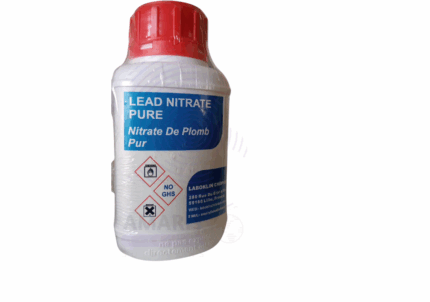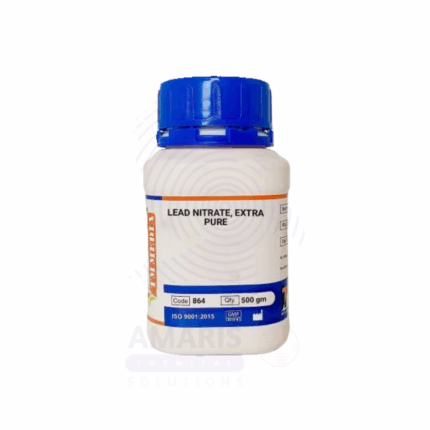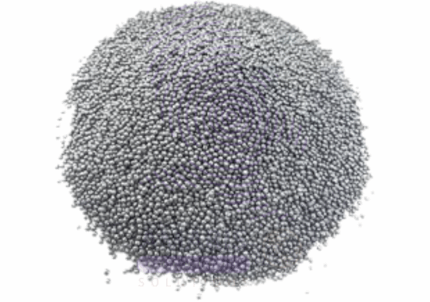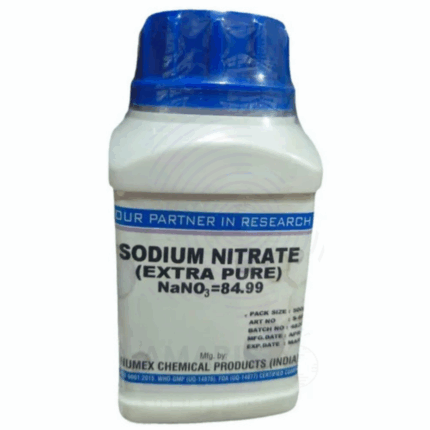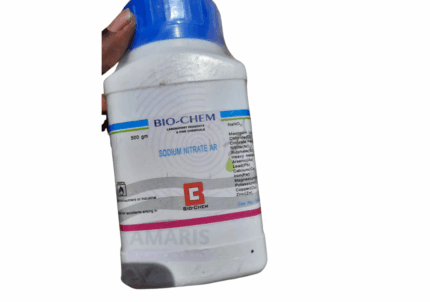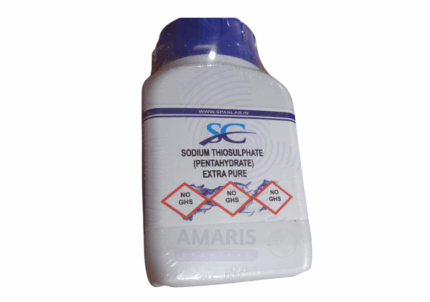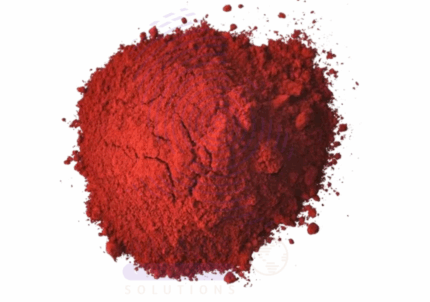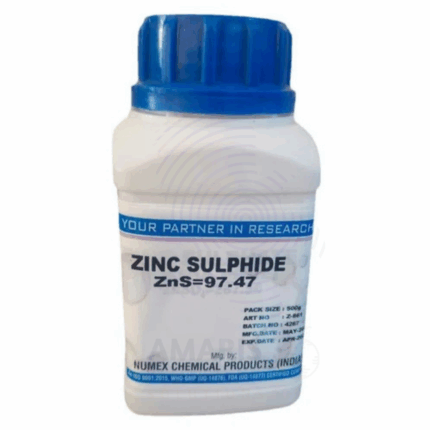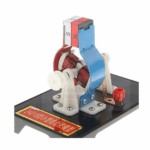

Potassium Chlorate Extra Pure
$ 18.00 Original price was: $ 18.00.$ 17.87Current price is: $ 17.87.
Potassium Chlorate Extra Pure is a high-purity, crystalline compound with the chemical formula KClO₃. It appears as a white, odorless solid and is well known for its strong oxidizing properties. In its Extra Pure form, it meets analytical-grade standards, making it suitable for sensitive laboratory and controlled industrial applications.
This chemical is extensively used in analytical chemistry, especially in oxygen production experiments and thermal decomposition studies, as it decomposes to release oxygen when heated. It is also used as a reagent in pyrotechnics, match compositions, and explosive formulations, where a powerful oxidizer is needed. In botanical tissue culture, potassium chlorate is sometimes used to induce flowering in certain plant species.
Due to its reactive and potentially explosive nature, Potassium Chlorate must be handled with extreme caution. It should be stored away from combustible materials, acids, and heat sources, in a cool, dry, well-ventilated area, in tightly sealed containers. Personal protective equipment such as gloves, goggles, and lab coats must be worn during handling, and it should never be ground or mixed with sulfur, phosphorus, or organic matter unless under strictly controlled conditions.
Potassium Chlorate Extra Pure
PRIMARY USES
- Laboratory Reagent:
- Widely used as an oxidizing agent in analytical and synthesis reactions.
- Facilitates oxygen generation experiments (e.g., thermal decomposition with manganese dioxide catalyst).
- Pyrotechnics & Explosives:
- Essential in fireworks, matches, and signal flares for its strong oxidizing properties.
- Promotes intense combustion and vibrant flame coloration.
- Disinfectants & Germicides:
- Acts as a component in mouthwashes and throat lozenges (in very controlled doses).
- Historically used for its antiseptic properties.
SECONDARY USES
- Agriculture (limited use):
- Previously used as a herbicide and defoliant, though now largely restricted due to safety concerns.
- Textile and Dye Industry:
- Employed in bleaching and dyeing processes as an oxidizing agent.
- Chemical Manufacturing:
- Intermediate in the production of oxygen-rich compounds and specialty chemicals.
1. Basic Identification Attributes
- Chemical Name: Potassium Chlorate
- CAS Number: 3811-04-9
- HS Code: 2829.19.00
- Molecular Formula: KClO₃
- Synonyms:
- Chloric acid, potassium salt
- Potassium salt of chloric acid
- UN No. 1485
2. Physical & Chemical Properties
- Physical State: Solid (crystalline powder)
- Color & Odor: White crystals or powder, odorless
- Boiling Point & Melting Point:
- Melting Point: ~356 °C (decomposes)
- Decomposes before boiling
- Density/Specific Gravity: ~2.34 g/cm³
- Solubility:
- Soluble in water (~7.3 g/100 mL at 25 °C)
- Insoluble in alcohol and organic solvents
- pH Level: Neutral to slightly basic in aqueous solution
- Vapor Pressure & Volatility: Not volatile
- Flash Point: Not applicable (non-flammable itself)
- Autoignition Temperature: Not applicable
- Viscosity: Not applicable
3. Safety & Hazard Attributes
- Hazard Class (GHS Classification):
- Oxidizing solid (Category 1)
- Acute toxicity (Oral, Category 4)
- Skin and eye irritant
- NFPA Ratings:
- Health: 2
- Flammability: 0
- Reactivity: 3 (strong oxidizer)
- Exposure Limits:
- No specific OSHA PEL or ACGIH TLV
- Reactivity:
- Strong oxidizer; reacts violently with organic materials, sulfur, phosphorus, and reducing agents
- May cause explosive mixtures with combustible materials
4. Storage & Handling Attributes
- Storage Conditions:
- Store in a cool, dry, well-ventilated, and segregated area
- Keep away from heat, flames, and incompatible substances
- Incompatible Materials:
- Organic matter, sulfur, phosphorus, powdered metals, strong acids, reducing agents
- Container Type:
- Glass, high-density plastic containers (non-reactive)
- Shelf Life & Expiration Date:
- Stable when dry; store tightly sealed to avoid moisture uptake
- Special Handling Requirements:
- Use chemical-resistant gloves, safety goggles, and dust mask
- Avoid friction, impact, or contamination during handling
5. Regulatory & Compliance Attributes
- Regulatory Status:
- Regulated under OSHA, REACH, EPA
- Controlled in some jurisdictions due to explosive potential
- Transportation Restrictions:
- UN Number: 1485
- Hazard Class: 5.1 (oxidizer)
- Packing Group: II
- Waste Disposal Method:
- Dispose of as hazardous waste according to local environmental regulations
- Do not dispose into drains or combust with flammable waste
6. Environmental & Health Impact
- Ecotoxicity:
- Harmful to aquatic organisms at high concentrations
- Persistence in Environment:
- Decomposes into chloride and oxygen; not persistent
- Carcinogenicity/Mutagenicity:
- Not classified as carcinogenic or mutagenic
- Biodegradability:
- Inorganic; does not biodegrade, but breaks down through chemical processes
SAFETY PRECAUTIONS
Personal Protective Equipment (PPE):
- Use chemical-resistant gloves (e.g., nitrile).
- Wear safety goggles and a face shield for full eye and face protection.
- Lab coat and anti-static protective clothing recommended.
- Use a suitable respirator if dust is generated.
Handling:
- Handle in a spark-free, well-ventilated environment.
- Avoid friction, heat, shock, or contact with organic materials.
- Do not mix with combustible or reducing substances.
- Prevent buildup of dust and avoid inhalation.
Storage:
- Store in a tightly closed, corrosion-resistant container.
- Keep in a cool, dry, and well-ventilated place.
- Isolate from acids, organic materials, and flammable substances.
- Label clearly as an oxidizer.
FIRST AID MEASURES
Inhalation:
- Move people to fresh air.
- Seek medical attention if respiratory symptoms develop.
Skin Contact:
- Wash thoroughly with soap and water.
- Remove contaminated clothing.
- If irritation persists, consult a physician.
Eye Contact:
- Rinse with copious amounts of water for at least 15 minutes.
- Lift eyelids and flush thoroughly.
- Seek immediate medical help.
Ingestion:
- Rinse mouth with water.
- Do NOT induce vomiting.
- Seek immediate medical attention—may cause internal oxidative damage.
FIRE FIGHTING MEASURES
Flammability:
- Not flammable by itself but a powerful oxidizer—can intensify fires.
Extinguishing Media:
- Use water spray, dry chemical, or CO₂.
- Avoid using dry combustible materials like sawdust or cloth.
Hazardous Combustion Products:
- Releases toxic gases such as chlorine, potassium oxides, and oxygen under fire conditions.
Firefighter Protection:
- Use full-body flame-resistant gear and self-contained breathing apparatus (SCBA).
- Cool containers with water to prevent rupture.
- Keep distance—risk of explosion if heated.


 Preservatives(food)
Preservatives(food) Flavor Enhancers
Flavor Enhancers Acidulants
Acidulants Sweeteners
Sweeteners Antioxidants
Antioxidants Colorants(food)
Colorants(food) Nutraceutical Ingredients (food)
Nutraceutical Ingredients (food) Nutrient Supplements
Nutrient Supplements Emulsifiers
Emulsifiers
 Collectors
Collectors Dust Suppressants
Dust Suppressants Explosives and Blasting Agents
Explosives and Blasting Agents Flocculants and Coagulants
Flocculants and Coagulants Frothers
Frothers Leaching Agents
Leaching Agents pH Modifiers
pH Modifiers Precious Metal Extraction Agents
Precious Metal Extraction Agents
 Antioxidants(plastic)
Antioxidants(plastic) Colorants (Pigments, Dyes)
Colorants (Pigments, Dyes) Fillers and Reinforcements
Fillers and Reinforcements Flame Retardants
Flame Retardants Monomers
Monomers Plasticizers
Plasticizers Polymerization Initiators
Polymerization Initiators Stabilizers (UV, Heat)
Stabilizers (UV, Heat)
 Antifoaming Agents
Antifoaming Agents Chelating Agents
Chelating Agents Coagulants and Flocculants
Coagulants and Flocculants Corrosion Inhibitors
Corrosion Inhibitors Disinfectants and Biocides
Disinfectants and Biocides Oxidizing Agents
Oxidizing Agents pH Adjusters
pH Adjusters Scale Inhibitors( water)
Scale Inhibitors( water)
 Antioxidants(cosmetic)
Antioxidants(cosmetic) Emollients
Emollients Fragrances and Essential Oils
Fragrances and Essential Oils Humectants
Humectants Preservatives
Preservatives Surfactants(cosmetic)
Surfactants(cosmetic) Thickeners
Thickeners UV Filters
UV Filters
 Fertilizers
Fertilizers Soil Conditioners
Soil Conditioners Plant Growth Regulators
Plant Growth Regulators Animal Feed Additives
Animal Feed Additives Biostimulants
Biostimulants Pesticides (Herbicides, Insecticides, Fungicides)
Pesticides (Herbicides, Insecticides, Fungicides)
 Active Pharmaceutical Ingredients (APIs)
Active Pharmaceutical Ingredients (APIs) Excipients
Excipients Solvents(pharmaceutical)
Solvents(pharmaceutical) Antibiotics
Antibiotics Antiseptics and Disinfectants
Antiseptics and Disinfectants Vaccine Adjuvants
Vaccine Adjuvants Nutraceutical Ingredients (pharmaceutical)
Nutraceutical Ingredients (pharmaceutical) Analgesics & Antipyretics
Analgesics & Antipyretics
 Analytical Reagents
Analytical Reagents Solvents(lab)
Solvents(lab) Chromatography Chemicals
Chromatography Chemicals Spectroscopy Reagents
Spectroscopy Reagents microbiology-and-cell-culture-reagents
microbiology-and-cell-culture-reagents Molecular Biology Reagents
Molecular Biology Reagents Biochemical Reagents
Biochemical Reagents Inorganic and Organic Standards
Inorganic and Organic Standards Laboratory Safety Chemicals
Laboratory Safety Chemicals Specialty Laboratory Chemicals(Special Laboratory Equipment)
Specialty Laboratory Chemicals(Special Laboratory Equipment)
 Demulsifiers
Demulsifiers Hydraulic Fracturing Fluids
Hydraulic Fracturing Fluids Scale Inhibitors(oil)
Scale Inhibitors(oil) Surfactants(oil)
Surfactants(oil) Drilling Fluids
Drilling Fluids
 Dyes and Pigments
Dyes and Pigments Bleaching Agents
Bleaching Agents Softening Agents
Softening Agents Finishing Agents
Finishing Agents Antistatic Agents
Antistatic Agents
 Admixtures
Admixtures Waterproofing Agents
Waterproofing Agents Sealants and Adhesives
Sealants and Adhesives Curing Compounds
Curing Compounds Concrete Repair Chemicals
Concrete Repair Chemicals Anti-Corrosion Coatings
Anti-Corrosion Coatings
 Surfactants(cleaning)
Surfactants(cleaning) Builders
Builders Enzymes
Enzymes Solvents (Cleaning)
Solvents (Cleaning) Fragrances
Fragrances
 Electronic Chemicals
Electronic Chemicals Catalysts
Catalysts Lubricants
Lubricants Photographic Chemicals
Photographic Chemicals Refrigerants
Refrigerants Automotive chemicals
Automotive chemicals Pyrotechnic Chemicals
Pyrotechnic Chemicals
 Biodegradable Surfactants
Biodegradable Surfactants Bio-based Solvents
Bio-based Solvents Renewable Polymers
Renewable Polymers Carbon Capture Chemicals
Carbon Capture Chemicals Wastewater Treatment Chemicals
Wastewater Treatment Chemicals
 Pigments
Pigments Solvents(paint)
Solvents(paint) Specialty Coatings
Specialty Coatings Binders/Resins
Binders/Resins Additives
Additives Driers
Driers Anti-Corrosion Agents
Anti-Corrosion Agents Functional Coatings
Functional Coatings Application-Specific Coatings
Application-Specific Coatings
 Fresh Herbs
Fresh Herbs Ground Spices
Ground Spices Whole Spices
Whole Spices Spice Blends
Spice Blends Dried Herbs
Dried Herbs
 Leavening Agents
Leavening Agents Dough Conditioners
Dough Conditioners Flour Treatments
Flour Treatments Fat Replacers
Fat Replacers Decoratives
Decoratives Preservatives(baking)
Preservatives(baking)
 Plasticizers & Softeners
Plasticizers & Softeners Reinforcing Agents
Reinforcing Agents Adhesion Promoters
Adhesion Promoters Vulcanizing Agents
Vulcanizing Agents Antidegradants
Antidegradants Blowing Agents
Blowing Agents Fillers & Extenders
Fillers & Extenders Accelerators & Retarders
Accelerators & Retarders